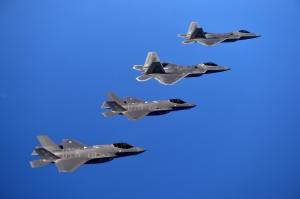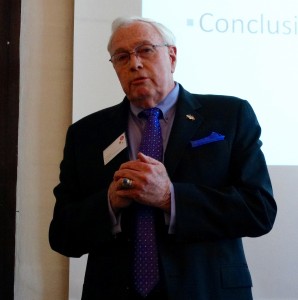2015-05-01 Ed Timperlake, editor of the Second Line of Defense Forum, was the last speaker of the day prior to the wrap up of the Danish airpower symposium.
The title of his briefing was “Early 21st Century Warfighting Trends: Technology, Training and Tactics,” and focused on the intersection of the coming of the F-35 with the evolving warfighting environment for the US and its allies.
In effect, he provided a look at the synergy of what John Blackburn discussed through Plan Jericho between the F-35 as a trigger for change, and the evolving approach of the RAAF or what Lt. Col. Berke referred as the disruptive change associated with the F-35 and the evolving eco system associated with fifth generation warfare.
As a Marine Corps pilot engaged in both close air support and air-to-air missions, Timperlake completed his flying career as Commanding Officer of VMFA-321 with over 3000 hours of tactical flying.
Timperlake was looking forward from the perspective of the way ahead for performing the mixture of missions pilots would need to deliver in the coming decade.
A core element of working the evolving future is understanding that even with a disruptive change platform like the F-35, it is intersection of the training and tactics for the platform with the overall capabilities of the force which will drive change, And it is the squadrons and the squadron pilots who are the heart of shaping innovation.
As Lt Col. Berke had highlighted, change was a significant part of what the F-35 was all about for the pilots and their roles.
Timperlake underscored that in visits to the core warfighting centers in the United States associated with airpower – Nellis, Fallon and MAWS-1 – the warfighters had embraced change and were working across the services and with the allies in shaping new combat approaches.
As one who had met John Boyd and sat through his lectures a couple of times, Timperlake focused on how the famous OODA loop was being re-shaped with the coming of the F-35 fleet whereby the “Decide-Act” part of the OODA loop was increasingly important.

The ability of the pilots to share situational awareness across the fleet, and to support one another’s operations over significant distance in compressed time meant that the force would have significant capability to deliver kinetic strike either by itself or from other platforms.
And the passive sensing capabilities of the F-35 would introduce innovations in kinetic and non-kinetic strike as well.
One way to understand the evolving eco system associated with fifth generation warfare is the S-cubed revolution.
Stealth, speed and sensors are an interactive dynamic and underlay the emergence of fifth generation warfare.
The sensor-shooter revolution sees as well the emergence of the offensive-defensive enterprise.
Sensors, stealth and speed enable the air combat enterprise to find, kill and respond effectively to the numerous adversarial threats that global powers and pop up forces can present to the US and its allies.
The strategic thrust of integrating modern systems is to create a honeycomb that can operate in an area as a seamless whole, able to strike or defend simultaneously.
This is enabled by the evolution of C5ISR (Command, Control, Communications, Computers, Combat Systems, Intelligence, Surveillance, and Reconnaissance), and it is why Secretary Wynne has underscored for more than a decade that fifth generation aircraft are not merely replacements for existing tactical systems but a whole new approach to integrating defense and offense.
By shaping a C5ISR system inextricably intertwined with platforms and assets that can honeycomb an area of operation, an attack and defense enterprise can operate to deter aggressors and adversaries or to conduct successful military operations.
The F-35 global fleet will help shape the new ecosystem and live off it. Synergy in shaping evolving capabilities to deal with the reactive enemy will be an essential part of the innovations associated with the offensive-defensive enterprise.

Timperlake argued that the warfighting centers were interactively working together and with allies to shape the way ahead.
Each center has an evolving special focus that will carry forth innovation across the entire warfighting enterprise.
MCAS Yuma, MAWTS-1, VMX-22 and the F-35 squadron, were working together to shape an innovative approach to 21st century close air support within which the cockpit display gave the pilot a constant read of the AA and GA threats and in which electronic warfare was part of the CAS capabilities of the aircraft. And with the integration with the Osprey and with the MAGTF, the Marines were shaping a whole new approach to assault forces.
Visiting the Warfare Center at Nellis, Timperlake learned of the central importance of shaping a fleet wide mission data set correlated with the F-35 sensors in shaping wide ranging SA and engagement force decision making. With Red Flag exercises the USAF was leading the way in shaping the intersection of the F-35 with other combat assets to shape an air combat revolution that will help reshape an ecosystem that would evolve with the F-35 fleet.
At Fallon, the Navy is looking to lead the way on shaping a live virtual constructive range which will allow the complexities of a modern battlefield to be both inclusive and wide-ranging.
He saw the new carrier air wing evolving under the influence of the F-35 extending its reach and expanding the capabilities of the maritime force to deliver distributed lethality.
This is an open-ended learning process, but to use Lt. Col. Berke’s language, one which needs to be accelerated and to get on with it.
The systems making up the F-35 cockpit provide convergent capabilities but are driven by separate R and D paths to shape new 21st century capabilities. In other words, the F-35 and its evolving ecosystem are both inherent to change within the aircraft and synergistic with change in the entire air combat force.
The future is in the hands of the squadron pilots across the services, and the allies and change driven by any one service or F-35 nation will be part of the overall dynamic of re-shaping the eco-system.
This is a key advantage that the US and its allies can leverage to shape a more effective combat future and to position themselves effectively against adversaries like Russia, North Korea and China.
He concluded that “countless evolutionary and revolutionary aspects of 21st century combat will be in the hands of the squadron pilots – as it should be!”


